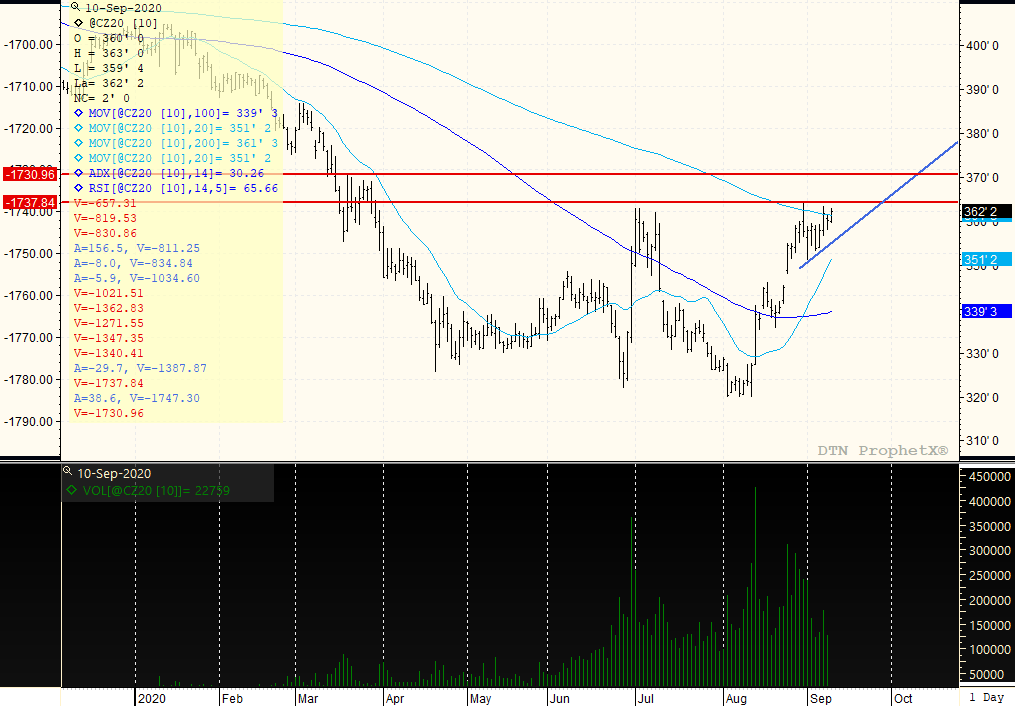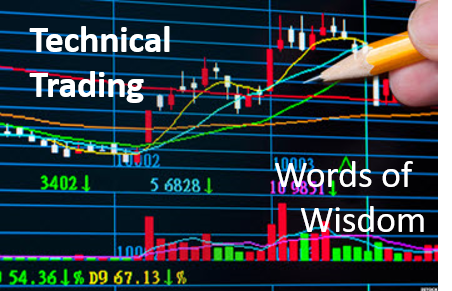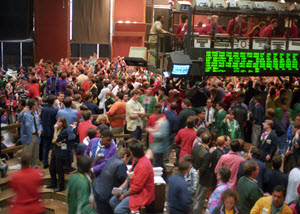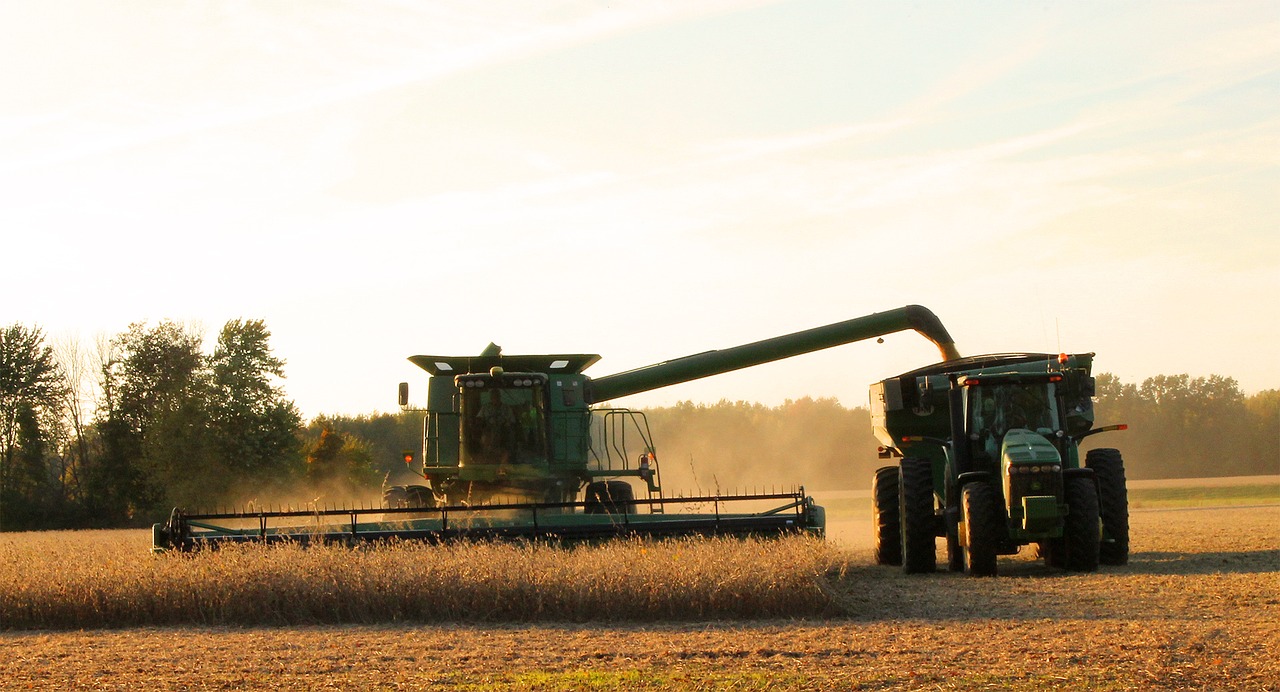SPREADS
October crush trades to 72c/bu while oilshare trades to 34.49%. Nov/Jan beans remain firm at 4 1/4c from 4 1/2c, vs. values that were out to 6c. Dec/Dec corn firms into 23 1/4c from 25 3/4c. Dec/March corn trades from 9 34c to 10 1/2c. Dec wheat/corn trades from 1.85c up to 1.88c.
PALM OIL
Nov down 2 ringgits, falling for a second straight session on lower -than-expected Sep. 1-10 exports and rising production, but a marginal rise in August inventories capped losses.
NEWS
Stocks have turned higher, up 44 pts. Crude oil is weaker down to $37.30/barrel, while the US dollar trades down to 92.18.
CALLS
Calls today are as follows:
beans: 1/2-1 higher
meal: .30-.40 higher
soyoil: 3-5 higher
corn: 1 1/2-2 higher
wheat: 5 1/2-6 1/2 higher
canola: .90-1.00 lower
BUSINESS
USDA reports 195,000 mt of beans sold to China for 20/21
TECHNICALS
December Corn: The market moved back over $3.60 and is up against minor trendline resistance at $3.63. Therefore, a move over $3.63 sets the stage for a test of market tops at $3.65. Clearing these market tops with an ascending triangle underneath will promote further buying and a target high of $3.68-$3.72.
first support: $3.58
resistance: $3.63
possible range: much the same or higher
December Wheat: Prices held the 200-day moving average again at $5.42 which promoted a market bounce to $5.50. Clearing $5.51 sets the stage for a broader rally, and just the ability to hold a key moving average with higher trade implies that upper retracement levels are possible. Would look for further strength and a test of $5.55 for the day as prices move sideways from $5.40-$5.70.
first support: $5.45
resistance: $5.54/$5.55
possible range: much the same
November Beans: Prices reached a new high for the rally at $9.81 3/4 and begins the day very close to that level. Shallow pullbacks move support up to $9.75, and would look for a possible new high again today on a firmer start with trendline resistance at $9.83. The market is extremely overbought with an RSI of 82, and typically markets find reversal trade when extremes of 85/88% are in place. The path of least resistance remains higher, and price action is more suggestive of a trade towards $9.90-$10.00 than not.
first support: $9.75
resistance: $9.81/$9.83
possible range: much the same or lower
December Soyoil: Prices are taking a healthy time-out from the up-trend with a classic pennant formation with trendline support at 3310c and resistance at 3375c. Though the market is moving sideways, the major trend is up and the ADX confirms a still strong market with a reading of 44. The market is still set up for a test of 34c once again, and would continue to buy breaks unless we take out and trade under 3250c.
first support: 3310c
resistance: 3375c
possible range: much the same or higher
December Meal: Prices reached a trading range high of $319.90 and sits close to market top to begin the day. Meal has a habit of testing new tops when one has been placed. Better support moves up to $316.00, and would look for a test of $320.00 which is trendline resistance. The uptrend has strengthened with a reading of 30, meaning pullbacks are now likely to hold. Double lows at $313.00 are now good lower support levels in a market that has not yet seemed to have placed its overall trading range high.
first support: $317.00
resistance: $319.50-$320.50
possible range: much the same
DECEMBER CORN
Overall trading range is from $3.50-$3.65. The market is building a new support line as shown in blue, with trendline support moving up to $3.58. The series of higher lows and tops at $3.65 presents as an ascending triangle, which is more suggestive of higher prices ahead. Clearing $3.65 targets $3.69/$3.70. The ADX is strengthening a bit at 30, meaning that the uptrend is getting stronger and traders will now look for dips to own. The market may continue to congest around its 200 day moving average of $3.61 into the report, but the ability to move back over resistance levels is more positive in terms of technical trade than negative.

TAGS – Feed Grains, Soy & Oilseeds, Wheat, North America



 Friday’s strength in CBOT and broader global ag commodity futures was simply a foreshadowing of the rallies that would develop on Monday. Heading into the weekend, markets were jittery on perceived weather risks, many of which turned out to be prescient. Over the weekend, parts of the U.S...
Friday’s strength in CBOT and broader global ag commodity futures was simply a foreshadowing of the rallies that would develop on Monday. Heading into the weekend, markets were jittery on perceived weather risks, many of which turned out to be prescient. Over the weekend, parts of the U.S...
 Update for 1 April 2024: Last year, users pointed out differences between the 5-year averages reported in this app and what USDA estimates in its weekly report. The difference exists because WPI calculates average based on the last 5 years of observations for the current week. In cases where ob...
Update for 1 April 2024: Last year, users pointed out differences between the 5-year averages reported in this app and what USDA estimates in its weekly report. The difference exists because WPI calculates average based on the last 5 years of observations for the current week. In cases where ob...
 Trading Waste Rich Westerners consumed so much plastic that even though landfills take much of it, their export of plastic waste now overwhelms Asia. Then Western policymakers gave yellow grease (used cooking oil) a very low carbon score for use as energy since it is a form of recycling. With h...
Trading Waste Rich Westerners consumed so much plastic that even though landfills take much of it, their export of plastic waste now overwhelms Asia. Then Western policymakers gave yellow grease (used cooking oil) a very low carbon score for use as energy since it is a form of recycling. With h...